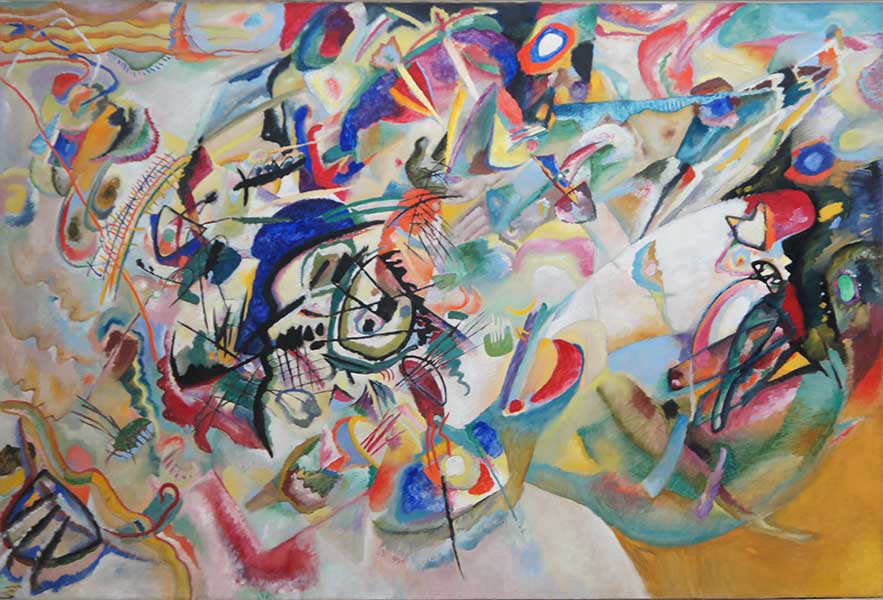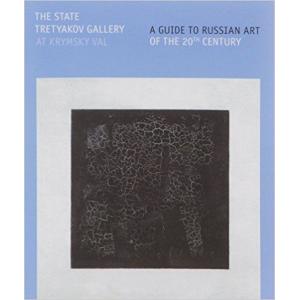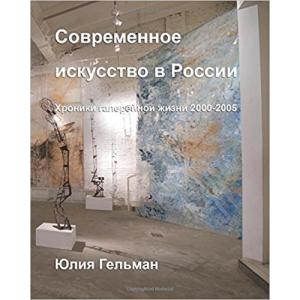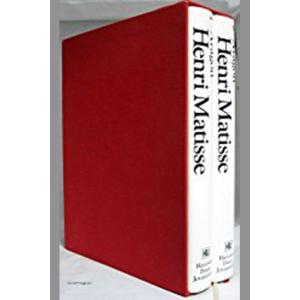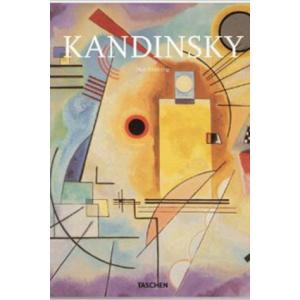Mothers, Disasters and Eye Balls
by Cathy Locke
Art movements in Russia made a dramatic shift with Stalin’s death in 1953, marking the end of Soviet Realism and the beginning of Russian contemporary art. Unlike the clear artistic style of Soviet Realism, this next period of art in Russia lacks a common stylistic denominator. Perhaps in a direct response to the severe restrictions of Stalin’s Soviet Realism, Russian artists went off in numerous creative directions experimenting with new painting styles and themes. The Khrushchev Thaw (1953-1964) began opening doors for artists giving them more creative freedom. Artists working in the style of Russian Impressionism included Arkady Plastov (1893-1972), Sergey Tkachev (b. 1922) and Alexey Tkachev (b. 1925), who all worked with themes of Russian country life. Younger Russian artists like Maxim Kantor (b. 1957) and Natalia Nesterova (b. 1944) worked with more politically explosive concepts that made comments on Soviet life. The Russian people saw greater openness in expression that resulted in landmark reforms in their political system. Mikhail Gorbachev (b. 1931) gave birth to perestroika in the 1980s, which in Russian literally means "restructuring," referring to the restructuring of the Soviet political and economic system. Many believe perestroika was the cause of the revolutions of 1989 in Eastern Europe that brought an end to the Cold War that same year; then two years later the dissolution of the Soviet Union in 1991. Looking back it was a period of explosive transformation both politically and artistically. An interesting side note to the Soviet contemporary art scene of the 1970s-80s is the emergence of women artists. Simon de Pury, Sotheby's European managing director, said the following in 1988, “Another ‘reflection’ of the Soviet contemporary art scene is that 26 of the 119 works offered for sale were made by women, a surprisingly high proportion by Western standards. In Sotheby's May 2 auction of American and European contemporary art in New York, only three of the 53 lots were women's work. A sale of 63 contemporary pieces the following day at Christie's included two by women.1
Arkady Plastov (1893-1972) Arkady Plastov never gave up ties to his country home in the village of Prisionikh, south of Moscow. Many believe it was the distance from Moscow that gave him the artistic freedom that he so valued, because he wasn’t under the watchful eye of Stalin. Plastov devoted the majority of his paintings to peasant life around his village. Though he is often categorized as a Soviet Realist, his work did not always correspond to that ideal. The reality is that his style of painting fits more into Russian Impressionism. Plastov’s art brought together impressionist traditions and the genre based art of the Wanderers. In his painting Spring, Plastov depicts a mother giving everything to her child. The concept of nakedness “in Soviet art had a social and political basis, and was most often interpreted as the ‘uniform’ of those playing sport or of embittered workers.”2 In Spring the artist depicts a typical village scene in a communal bathhouse, but here we are witnessing a miracle. It is precisely this miracle that departs from Soviet Realism and becomes a carefully fused message to the viewer. Painted the year after Stalin’s death, Plastov is giving hope to the youth of Russia. The bitterness of winter is over; now is a time of renewal of life, its beauty and truth.
Sergey Tkachev (b.1922) and Alexey Tkachev (b. 1925) Sergey and Alexey Tkachev are brothers who have been working together on paintings since 1950. Their work is linked to the ideology of pochvennichestvo, meaning the return to the soil, which sprang up in the 1960s in Russia. At the heart of the Tkachev brothers' work is the drama of day-to-day life in the countryside of Russia. Their painting Mothers is one of their very first works together. The women are shown sitting in a row looking straight on at the viewer. Wanting to create the visual message of Mother Earth the artists took a worm’s eye view in order to bind the viewer and the women to the ground. The women represent various stages of life. Rather than trying to standardize motherhood, as in Soviet Realism, the Tkachev brothers are instead depicting the journey from birth to death. The artists made a conscious decision to not make the women beautiful, focusing instead focus on their hands, which are overworked as a result of long years of hard labor. “When the painting was put on display at the All-Union exhibition in Manezh, civil servants from the USSR’s Ministry of Culture criticized its gloominess and interpreted it as a parody of Soviet mothers”3 The artists were forced to change its title to On the Bench, but the title was changed back to Mothers in the 1990s. In the context of the politics of Soviet Russia during the 1960s this painting took on special meaning. The agricultural policy under Khrushchev kept farmers from making money off of their livestock, which led to hundreds of old villages being wiped off the map. There was a mass exodus of the population from rural areas to the cities, primarily to work in manufacturing to support the defense industry. To the “artists of the sixties” the village was a symbol of the last outpost of spirituality.
Maxim Kantor (b. 1957) Focusing on one of the biggest events of the 1980s, Maxim Kantor created his polyptych – Chernobyl. The Wormwood Star. – after the April 26, 1986 explosion at the Chernobyl nuclear power station in the Ukraine. This large monumental work (130” tall x 160” wide) consists of eleven panels and was created using tempera, oil paint and plaster. On the surface of the painting Kantor has embedded fragments of cloth and metal grills. This approach of “defacing” a canvas was common among the Italian Trans-avant garde and German Neo-expressionists working in the mid-1980s. His atypical approach combined with great interest among the Russian population in the event itself attracted huge attention to this work. Within Russia… “the Cold War atmosphere and the very real nuclear threat led to an outbreak of religious eschatological fever, in a society which had lost faith in Socialist ideals. The Ukrainian word chernobyl translates as “wormwood,” and therefore for those who knew their Holy Scripture were put to mind the book of Revelations, in which Christ’s Revelation to St. John spoke of the Wormwood star: ‘and a great star, blazing like a torch, fell from the sky on a third of the rivers and on the springs of water. The name of the star is Wormwood. A third of the waters turned bitter, and many people died from the waters that had become bitter.’ (Rev. 8;10) .”4
Kantor uses the traditional shape of wooden European triptych altars, which consisted of a central composition, side flaps and a bottom flap. He got this idea from the German Neo-expressionists of the twentieth century who also used the shapes of altar paintings. Instead of creating a composition of complementary components, Kantor purposely fragments his composition to create an uneasy effect. The center of Kantor’s composition consists of full-length figures painted in gray colors to represent ash or dust. His heroes are like prisoners in a concentration camp covered in camp dust. These heroes are victims of environmental, political and social catastrophes that took place in the twentieth century. Each person is placed separately on one panel to symbolize the value of human life. Within the grouping Kantor paints his parents and himself, as a gesture of solidarity with both the living and the dead. In fact, on closer look each of these figures appears to be lying down as if in a coffin. Maxim Kantor writes this about his painting, “In all the paintings (of those years) I depicted the family. The premise was that history is not someone else’s business, but it is actually our business, everything happens directly with us, today. And through the history of the family I wrote the history of the country. The 'avant-garde' public of that time accepted the painting critically – they saw it was too topical: criticizing Stalin was relevant, while drawing Chernobyl was somehow too political. I showed the painting for the first time at a one-day festival at Kuznetsky Most – a half-underground area given for one evening. There were debates. It was displayed in Manezh a year later. Then I was invited to the Ministry of Culture, and the deputy minister of art at that time, Genrikh Popov, said that I must find a figure equal to me – not with a negative, but a positive pathos, and then my work could be displayed. And he advised me to paint a canvas for the twentieth anniversary of the liberation of Czechoslovakia. I refused rudely. That refusal was discussed in the lunchroom of the Union of Artists, and there was a of drinking.”5
Natalia Nesterova (b. 1944) One prominent female Russian artist who made an important contribution to the art scene in the 1980s was Natalia Nesterova. Scenes of life in Moscow are one of Nesterova’s favorite themes. The artist constructs everyday scenes with her own twist of surrealist illusions. She is amongst the figurative artists of the 1980s who portray human beings in a troubling light, echoing the mood of German Neo-expressionism. In her painting Moscow. Triptych. we see a crowd of people elbowing their way in front of each other to see the city skyline of Moscow. As viewers of this painting we have to ask ourselves why are the people covered in eyes? Is this a comment echoing back to the days of Stalin when neighbors spied on each other and no one was safe under the “eyes” of the Soviet secret police? Having been born in 1944, Nesterova certainly would have been raised in the crowded apartment buildings of Moscow, where several families lived in one two-bedroom apartment. On closer look we see the skyline is only comprised of Stalin’s Seven Sisters. These seven skyscrapers, built from 1947 to 1953, were designed in the Stalinist style, an elaborate combination of Russian baroque and gothic styles What is odd is there isn’t a viewing platform in Moscow where one can see all seven buildings from one place. Nesterova has created a fantasy to reinforce the concept that Stalin is everywhere, permeating all of Moscow. The people in this painting are no longer individuals; they have been transformed into amorphous monuments. In fact Nesterova uses a type of modeling paste to build the figures up from the flat canvas creating a sculptural effect. Moscow. Triptych. was painted in 1989 at the height of perestroika, a time when the people of Russia were losing faith in Soviet values. The painting becomes the artistic voice and a symbol for the fall of the Soviet government.
Sources
- Suzanne Muchnic, Los Angeles Times: Sotheby's Moscow Sale an Opening to Soviet Art, May 30, 1988
- Anna Dikovich, Sergey Yepikhin, Alyona Rasskazova, Kirill Svetlyakov, Natalia Sidorova, Sofia Terekhova, Yana Shklyarskaya and Galina Shubina; The State Tretyakov Gallery at Krymsky Val: A Guide to Russian Art of the 20th Century; Paulsen Moscow, 2015, page 175.
- Anna Dikovich, Sergey Yepikhin, Alyona Rasskazova, Kirill Svetlyakov, Natalia Sidorova, Sofia Terekhova, Yana Shklyarskaya and Galina Shubina; The State Tretyakov Gallery at Krymsky Val: A Guide to Russian Art of the 20th Century; Paulsen Moscow, 2015, page 184.
- & 5. Anna Dikovich, Sergey Yepikhin, Alyona Rasskazova, Kirill Svetlyakov, Natalia Sidorova, Sofia Terekhova, Yana Shklyarskaya and Galina Shubina; The State Tretyakov Gallery at Krymsky Val: A Guide to Russian Art of the 20th Century; Paulsen Moscow, 2015, page 198.
About the Author:
Cathy Locke is an award-winning fine art painter, professor, and published writer, specializing in Russian art of the 19th and 20th centuries. She is the editor of Musings-on-art.org.
Cathy Locke’s artwork – www.cathylocke.com








